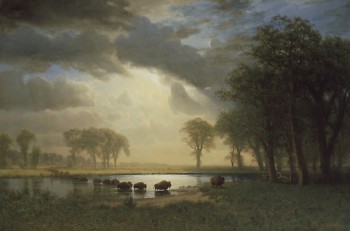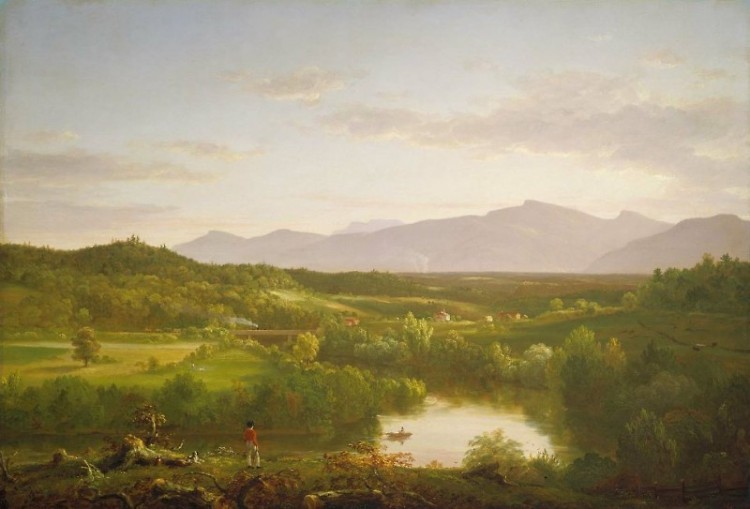"Masterpieces of American Landscape Painting 1820-1950" is a current show at the Grand Rapids Art Museum (GRAM). The show has come from the Boston Museum of Fine Arts (BFA)I came out of the new show at the Grand Rapids Art Museum (GRAM) with a whole new appreciation for American landscape painting. This was a subject of art history I had felt like I knew pretty well, but I was not prepared for how my heart was to be broken by the time I was only about a third of the way through the exhibit.
“Masterpieces of American Landscape Painting 1820-1950”, the current show at GRAM, has come from the Boston Museum of Fine Arts (MFA-Boston). It had its first stop in Nagoya Japan and now it is here in Grand Rapids until mid January 2014. MFA-Boston has the largest collection of American landscape paintings in the world. This is a truly world class showing of an incredible collection of 19th and 20th century American landscape paintings that most art lovers only know from their art history books. The painters in this show are nearly all heavyweights. Names like Thomas Cole, Albert Bierstadt, Martin Johnson Head, George Inness, Winslow Homer, Arthur Dove, Georgia O"Keeffe are all represented here.
One of the first paintings you see as you enter the exhibit is “River in the Catskills” (1843) by Thomas Cole. This painting happens to be the very first American painting to picture a locomotive in the landscape. There was actually a fair amount of controversy at the time regarding the debate of whether the train was a blessing or a curse. There were a number of people at the time, Cole being one of them, who thought the locomotive was ugly and loud and capable of ruining the landscape. It is interesting to see this early incarnation of environmental concern in the still very young America.
Another painting along these lines is “The Buffalo Trail” (1867) by Albert Bierstadt. Here the artist has portrayed a long line of very solemn looking buffalo on there way out of the picture forever. It was just 13 years after this painting was completed that we were left with only a few thousand of these magnificent animals on the continent. These paintings are all very beautiful views done with artistic skills and methods no longer exist today.
I couldn't help but feel sad as I walked through the galleries and spent time with these historic paintings. I kept thinking about how nearly all these views have been lost forever with the exception of the magnificent Niagara Falls. I grew up in Kentwood, Michigan in the 60s and 70s and I watched beautiful chunks of woods and fallow farm fields get turned into subdivision developments and strip malls. I lost my own boyhood paradise to developers. The places I used to go sketching after school are completely gone now as well.
Being in front of “Blue Niagara” by George Inness is a powerful experience. This large painting makes the water turning to mist and the magical effects of light its subject matter. The more I looked at this painting the more I seem to get lost in it as if I was beginning to turn to mist. I swear I could actually hear the thundering sound of water hitting the rocks is some distant part of my brain the longer I stood there. The placards beside this painting tells the charming story of how the painter when he first visited the falls was so taken with its powerful beauty that he ran off to an artist who lived nearby and borrowed brushes, paints and canvas so that he could attempt to capture what he was seeing and feeling for the first time. Innes went on to paint six different versions of the falls.
There is an early painting of the great falls by Samuel Morse, the inventor of the morse code, titled “Niagara Falls From Table Rocks.” In this painting the rainbow is painted with tiny silhouette figures in the foreground that enhances the dramatic sense of scale and sheer awe one can only experience in the presence of such a natural wonder.
There is a grouping of paintings from the 20th Century towards the back galleries including a personal favorite by Maurice Pendergast entitled “Sunset.” This charming painting is a large grouping of figures on the shore of what looks to be a park. The ladies are spread across the field of the painting almost like a paper dolls that creates an almost musical pattern of flat shapes and colors. There is something very pure and playful about the way Pendergast makes his pictures, like a return to the innocence of childhood.
Another stand out piece is the one by Georgia O'Keeffe simply called “Dunes.” This painting is tiny in comparison to many of the more spectacular pieces in the show and yet there is a monumentality in this humble painting that becomes increasingly intense the longer you linger with it. It’s as if this painting leads you into an inner stillness in much the same way that a quiet walk alone in the woods can do.
When seeing the show, visitors should remember that a good portion of these paintings were made long before the camera had come into common use. In these early times of America’s unspoiled landscape, artist drawings, paintings and prints were the only way to record and share these scenes with those who were unable to see them first hand. What an incredible position for artists to be in at the time. These artists were recording a landscape and in some instances its indigenous people just as these people and the natural environments were just beginning to slip away forever. In our world of global warming, depleted natural resources and over-population, these paintings become more significant as a call to appreciate and hold on to what we have left of our natural surroundings.
We came out of the museum into a beautiful Michigan October afternoon. For the rest of the day, every time I happened to be outside it seemed that the trees and the sky had become some how extra beautiful, almost like a painting.
The Rapidian, a program of the 501(c)3 nonprofit Community Media Center, relies on the community’s support to help cover the cost of training reporters and publishing content.
We need your help.
If each of our readers and content creators who values this community platform help support its creation and maintenance, The Rapidian can continue to educate and facilitate a conversation around issues for years to come.
Please support The Rapidian and make a contribution today.

